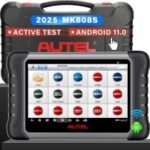Connecting a diagnostic tool to your car’s OBD2 port can feel like entering a secret world of codes and protocols. This guide demystifies the Obd2 Protocol List, explaining the different communication methods used by vehicles to transmit vital diagnostic information. Understanding these protocols is crucial for effective troubleshooting and vehicle maintenance.
Decoding the OBD2 Protocol List
An OBD2 compliant vehicle utilizes one of five communication protocols:
- ISO15765-4 (CAN-BUS): The most modern protocol, mandatory for all vehicles sold in the US since 2008. It uses pins 6 and 14 for differential communication. Four variations exist, differing in identifier length (11 or 29 bit) and bus speed (250 or 500 Kbaud).
- ISO14230-4 (KWP2000): Common in vehicles manufactured after 2003, leveraging the ISO9141 K-Line (pin 7). Two variants exist, distinguished by their initialization method (5 baud init or fast init), both operating at 10.4 Kbaud.
- ISO9141-2: Predominantly found in European vehicles between 2000 and 2004. It utilizes pin 7 and sometimes pin 15.
- SAE J1850 VPW: Primarily used in GM vehicles, operating on pin 1 at a speed of 10.4 kB/sec.
- SAE J1850 PWM: Commonly used by Ford, employing pins 1 and 2 for differential communication at 41.6 kB/sec.
Identifying Your Car’s OBD2 Protocol
You can often determine your vehicle’s protocol by examining the OBD2 connector’s pin configuration. The presence or absence of specific pins indicates the protocol in use.
| Standard | Pin 2 | Pin 6 | Pin 7 | Pin 10 | Pin 14 | Pin 15 |
|---|---|---|---|---|---|---|
| J1850 PWM | X | – | – | X | – | – |
| J1850 VPW | X | – | – | – | – | – |
| ISO9141/14230 | – | – | X | – | – | Opt. |
| ISO15765 (CAN) | – | X | – | – | X | – |
Beyond the Standard OBD2 Protocol List
While the five protocols listed above cover most OBD2 compliant vehicles, some manufacturers utilize proprietary protocols for communication with other vehicle control units (e.g., ABS, airbags). These require specialized diagnostic software tailored to the specific make and model.
Conclusion: Choosing the Right OBD2 Tool
Selecting the correct OBD2 diagnostic tool requires knowing your vehicle’s communication protocol. Tools like the ELM-USB interface support all standard OBD2 protocols, ensuring compatibility with a wide range of vehicles. Understanding the OBD2 protocol list empowers you to make informed decisions about diagnostic tools and effectively troubleshoot your vehicle’s systems.

